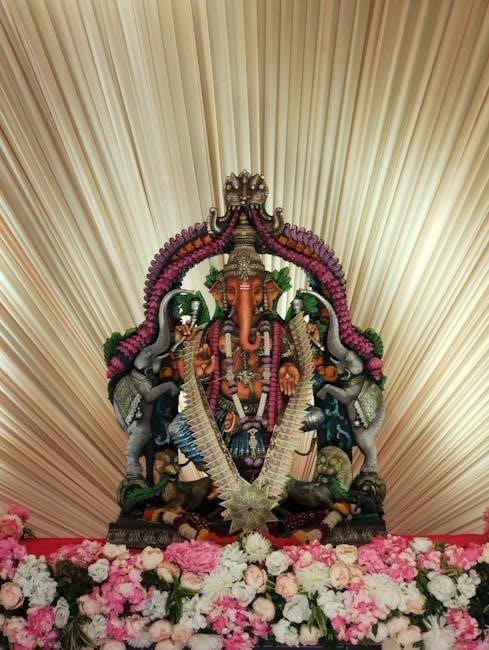Ernest Hemingway’s Hills Like White Elephants is a poignant short story exploring themes of abortion, communication breakdown, and power dynamics through a couple’s tense dialogue at a train station.
Overview of the Story
“Hills Like White Elephants” by Ernest Hemingway is a concise yet deeply symbolic narrative. The story revolves around a couple at a train station in Spain, contemplating a life-altering decision. The man and the woman, often referred to as “the American” and “Jig,” engage in a tense, understated conversation. Their dialogue hints at an unplanned pregnancy and the possibility of an abortion, though these details are never explicitly stated. The setting, a sparse, sun-drenched station between two contrasting landscapes, mirrors the emotional tension. The narrative’s subtlety leaves room for interpretation, focusing on the couple’s strained dynamics and the weight of their unspoken thoughts.
Significance of the Title
The title “Hills Like White Elephants” serves as a potent metaphor, symbolizing the central conflict of the story. The phrase, drawn from Hemingway’s sparse dialogue, reflects the tension between the couple. A “white elephant” often represents something valuable yet burdensome, mirroring the unborn child and the decision the couple faces. The hills, visually contrasting and distant, evoke a sense of inevitability and the weight of their choice. The title encapsulates the story’s emotional core, emphasizing the subtle yet profound struggle between the characters, and the lasting impact of their decision.
Context of the PDF Version
The PDF version of “Hills Like White Elephants” provides a convenient and accessible format for readers. It allows for easy annotation and bookmarking, making it ideal for academic or personal study. The PDF retains the story’s original formatting, ensuring the sparse, dialogue-driven narrative is preserved. This version is widely available online, enabling readers to engage with Hemingway’s work without physical copies. Its digital nature also makes it easily shareable for classroom discussions or individual analysis, offering a modern way to explore the story’s depth and complexity.
Setting
The story unfolds in a small, rural train station between Barcelona and Madrid, situated in the fertile yet desolate Ebro Valley. The surrounding hills and distant mountains create a stark, symbolic backdrop, contrasting fertility and barrenness. The station itself, with its simple architecture, embodies a transitional space, reflecting the couple’s emotional limbo. The train, symbolizing time and decision, looms in the distance, heightening the tension of their unresolved dilemma.
Physical Location: The Train Station
The story is set in a sparse, rural train station between Barcelona and Madrid, nestled in the Ebro Valley; The station’s simplicity, with its gravel platform and shaded waiting area, creates an atmosphere of quiet tension. Its remote location emphasizes isolation, while the passing trains symbolize movement and connection to the outside world. The station serves as a transitional space, reflecting the couple’s emotional state—caught between decisions and uncertain futures. The physical setting mirrors the characters’ internal conflict, with the station’s starkness underscoring the gravity of their conversation. Its minimalist design amplifies the emotional weight of the dialogue.
The Valley of the Ebro
The Valley of the Ebro serves as the backdrop for the story, its arid, sun-drenched landscape reflecting the emotional barrenness of the characters. The Ebro River, a significant geographical feature in Spain, flows through a region known for its stark beauty and dry terrain. Hemingway’s description of the valley emphasizes its desolation, mirroring the couple’s tense and uncertain relationship. The valley’s natural setting contrasts with the artificial environment of the train station, highlighting the characters’ isolation. Its presence underscores themes of fertility and sterility, subtly alluding to the central conflict of the story.
Symbolic Contrast Between the Two Sides of the Station
The train station in Hills Like White Elephants is divided into two contrasting sides, symbolizing the characters’ differing perspectives and the central conflict. One side is lush and fertile, with trees, while the other is dry and barren. This dichotomy reflects the couple’s emotional states and the decision they face. The fertile side may symbolize life, abundance, and the possibility of parenthood, while the barren side represents sterility, abortion, or the emptiness of their relationship. The contrast underscores the tension between hope and desolation, mirroring the characters’ internal struggles and the weight of their unresolved choices.
The Role of the Train
The train serves as a central element in Hills Like White Elephants, symbolizing decision, transition, and the inevitability of time. Its arrival and departure create a sense of urgency, pressuring the couple to make a choice about their future. The train station acts as a liminal space, representing a moment of pause before a life-altering decision. Hemingway uses the train to underscore the tension between action and inaction, as well as the irreversible nature of choices. It embodies the themes of movement, finality, and the necessity of commitment, amplifying the emotional stakes of the couple’s conversation.

Characters
The story focuses on two main characters: the American man and the girl (often called Jig). Their tense dialogue reveals their strained relationship and differing perspectives, highlighting emotional conflict and unspoken tensions between them.
The American Man
The American man is portrayed as assertive and detached, advocating for an abortion while downplaying Jig’s concerns. His dialogue reflects a lack of emotional engagement, prioritizing convenience over her feelings. His dismissive remarks, such as “I’ll go with you,” suggest insincerity. He embodies a controlling figure, pressuring Jig to conform to his desires. His character underscores themes of power imbalance and emotional detachment, highlighting the tension in their relationship.
The Girl (Jig)
Jig, the female protagonist, embodies vulnerability and indecision, grappling with the weight of her pregnancy and the prospect of abortion. Her dialogue reveals a deep desire for connection and understanding, contrasting with her partner’s detachment. Jig’s hesitation and emotional turmoil are evident as she contemplates the life-changing decision, seeking reassurance and clarity. Her character represents the emotional and moral complexity of the situation, highlighting the tension between personal autonomy and relational dynamics. Her subtle expressions of doubt and longing underscore the story’s exploration of choice and responsibility.
The Relationship Dynamics
The relationship between the American man and Jig is marked by tension and subtle power struggles. Their conversation reveals a lack of emotional connection, with the man appearing detached and Jig seeking reassurance. The man’s insistence on her making a decision highlights his desire for control, while Jig’s hesitation reflects her internal conflict. Their dialogue exposes a chasm in communication, with unspoken emotions and unresolved issues lingering beneath the surface. The dynamic underscores the imbalance in their relationship, emphasizing the man’s insensitivity and Jig’s vulnerability as she grapples with a life-altering choice.
The Age Gap and Its Implications
The age gap between the American man and Jig subtly influences their interaction and decision-making. The man, older and seemingly more experienced, exudes a sense of detachment, while Jig, younger and vulnerable, seeks emotional connection. This disparity highlights a power imbalance, with the man appearing more resigned to the situation. His maturity contrasts with Jig’s uncertainty, emphasizing her youth and the weight of the choice before her. The age difference underscores themes of experience versus innocence, as well as the societal norms of the time, where such relationships were commonplace yet fraught with underlying tensions and unspoken expectations.

Themes
The story explores themes of abortion, communication breakdown, power dynamics, freedom, responsibility, existentialism, and life choices, all intertwined to reflect the complexity of human relationships and decisions.
Abortion as the Central Theme
Abortion is the central, albeit unspoken, theme in “Hills Like White Elephants.” The couple’s strained dialogue subtly reveals their conflicting emotions regarding the decision. The white elephants symbolize the unwanted pregnancy, while the train station represents a critical juncture in their relationship. Hemingway’s subtlety mirrors the societal taboo surrounding abortion, allowing readers to interpret the characters’ dilemma through their interactions and surroundings. The emotional complexity and societal pressures faced by individuals in such situations are highlighted, reflecting the gravity of the decision and its impact on their lives.
Communication Breakdown
In “Hills Like White Elephants,” the couple’s dialogue is terse and indirect, reflecting a profound communication breakdown. The man and the woman avoid direct discussion of the abortion, instead using metaphors like white elephants and hills to express their feelings. Hemingway’s minimalist style emphasizes the silence between them, highlighting the emotional distance. The man’s dismissive remarks contrast with the woman’s emotional expressions, showing a lack of empathy and understanding. Their conversation underscores the difficulty of discussing sensitive issues, revealing deeper issues in their relationship and societal constraints of the time.
Power Dynamics in Relationships
In “Hills Like White Elephants,” the power dynamics between the American man and Jig are central to the narrative. The man, often seen as the dominant figure, attempts to influence Jig’s decision about the abortion, using persuasive language and emotional manipulation. His assertions, such as “I know you wouldn’t mind it” and “It’s not terrible,” reflect his effort to control the situation. Jig, however, exhibits quiet resistance, challenging his authority through subtle defiance. This tension highlights the imbalance in their relationship, where the man’s words carry more weight, yet Jig’s silence and resolve underscore her growing autonomy. The story subtly critiques gendered power structures, emphasizing the struggle for control in intimate relationships.
The Concept of Freedom and Responsibility
The story explores the tension between individual freedom and the responsibilities that come with life-altering decisions. The couple’s conversation revolves around the choice of abortion, symbolizing the clash between personal liberation and the burdens of commitment. The American man emphasizes freedom, advocating for a decision that aligns with his desire for an uninterrupted life. In contrast, Jig contemplates the weight of responsibility, reflecting on the potential consequences of their choice. This duality underscores the existential struggle of balancing autonomy with the accountability that accompanies significant life decisions. The narrative highlights how freedom, though desired, often comes with unforeseen responsibilities.
Existentialism and Life Choices
The story delves into existential themes, emphasizing individual freedom and the weight of decisions. The couple’s conversation revolves around an unnamed choice, symbolizing the existential crisis of making life-altering decisions. The man and the girl embody contrasting perspectives: he seeks to maintain their current lifestyle, while she contemplates a future with responsibility. Hemingway’s minimalistic style highlights the gravity of their dilemma, leaving the outcome ambiguous. This reflects existentialist ideas of self-determination and the burden of choice, allowing readers to interpret the characters’ ultimate decision. The narrative underscores the tension between desire for freedom and the realities of commitment.

Symbols and Imagery
- The hills resembling white elephants symbolize pregnancy and the weight of unresolved decisions.
- The train station represents a pivotal moment of choice and transition.
- Alcohol serves as a coping mechanism, reflecting underlying tensions and evasion.
- The curtain of bamboo beads acts as a barrier, mirroring emotional detachment.
The Hills as a Symbol of Pregnancy
In Hills Like White Elephants, the hills symbolize pregnancy and fertility, mirroring the natural, life-giving process Jig is contemplating. Their rounded, fertile appearance evokes imagery of a womb, while their white color suggests purity and innocence. The hills contrast sharply with the artificial “white elephants,” representing the tension between natural processes and human decisions. Hemingway uses the hills to highlight the central conflict: Jig’s potential motherhood versus the couple’s uncertain future. This imagery underscores the story’s exploration of choice, responsibility, and the emotional weight of decisions tied to pregnancy and relationships. The hills embody the natural world, while the characters navigate human complexity.
White Elephants and Their Meaning
The white elephants in Hills Like White Elephants serve as a powerful metaphor, symbolizing the central conflict of the story: the decision about the pregnancy. White elephants traditionally represent something valuable yet burdensome, often associated with unwanted gifts. In this context, the unborn child embodies this idea, as it signifies a life-changing responsibility. The elephants are never explicitly mentioned but are implied through the couple’s tense dialogue, highlighting the gravity of their decision; This metaphor underscores the themes of choice, responsibility, and the emotional weight of the situation, mirroring the couple’s internal struggle and the uncertainty of their future.
The Bar and Alcohol Consumption
The bar in Hills Like White Elephants serves as a neutral yet tense setting where the couple engages in sparse, meaningful dialogue. Alcohol consumption emerges as a coping mechanism, reflecting their emotional evasion. The couple orders drinks, which symbolize their attempt to escape the gravity of their conversation. The bar’s ambiance, with its bead curtain and sparse decor, mirrors the couple’s detachment. Drinking becomes a substitute for genuine communication, highlighting their inability to confront the reality of their situation. This subtle detail underscores the story’s themes of avoidance and the fragility of human connection.
The Curtain of Bamboo Beads
The curtain of bamboo beads in Hills Like White Elephants serves as a subtle yet significant symbolic element. It hangs in the doorway of the hotel, creating a visual and emotional barrier between the couple and the outside world. The beads, often associated with natural elements, contrast with the tension-filled atmosphere of the conversation. This curtain symbolizes the couple’s emotional separation and the fragility of their relationship. It also acts as a divider between public and private spaces, mirroring the internal conflict between openness and secrecy. The curtain’s presence underscores the story’s themes of isolation and the complexities of human connection.

Literary Devices
Hemingway’s Iceberg Theory is evident, with much of the story’s meaning existing beneath the surface, leaving interpretation to the reader.
The minimalistic writing style creates a stark, realistic atmosphere, emphasizing simplicity and clarity in dialogue and description.
Dialogue serves as a primary tool for characterization, revealing the tension and underlying emotions between the American and Jig.
Nature imagery, such as the hills and valley, reflects the characters’ emotional states and the gravity of their decision.
Hemingway’s Iceberg Theory
Ernest Hemingway’s Iceberg Theory is a literary approach where most of the story’s meaning lies beneath the surface, much like an iceberg. In Hills Like White Elephants, this technique is evident through sparse dialogue and subtle descriptions. The PDF version of the story maintains this style, requiring readers to infer emotions, motivations, and unspoken conflicts. Hemingway’s minimalist writing forces audiences to engage deeply, filling in gaps between the lines. This approach reflects the human tendency to communicate indirectly, especially in sensitive situations. The theory enhances the story’s emotional weight, leaving interpretation open to the reader’s perspective.
Minimalistic Writing Style
Hemingway’s minimalistic writing style in “Hills Like White Elephants” creates a sparse, understated narrative. The story avoids explicit descriptions, instead relying on subtle dialogue and implied meanings. This approach mirrors the iceberg theory, where most of the story’s depth lies beneath the surface. The concise prose forces readers to infer emotions and underlying tensions, enhancing the narrative’s emotional impact. For instance, the couple’s conversation about the white elephants is brief yet loaded with unspoken significance. This style underscores the themes of ambiguity and the complexity of human communication, leaving interpretations open to the reader’s perspective.
Dialogue as a Tool for Characterization
In Hills Like White Elephants, dialogue serves as a powerful tool for revealing character traits and underlying tensions. Hemingway’s sparse, direct conversations between the American and Jig expose their emotional states and relationship dynamics. The American’s terse, evasive responses contrast with Jig’s more emotional and probing questions, highlighting their differing perspectives. The dialogue subtly conveys the man’s detachment and Jig’s vulnerability, as well as the unspoken tensions surrounding their decision. Through their exchanges, Hemingway masterfully illustrates the complexity of their interaction, leaving much unsaid but heavily implied. This minimalist approach enhances the story’s emotional depth and ambiguity.
The Use of Nature as a Reflection of Human Emotions
In Hills Like White Elephants, Ernest Hemingway masterfully employs nature to mirror the emotional undertones of the characters. The hills, described as resembling white elephants, symbolize Jig’s pregnancy and the weight of their decision. The fertile, rounded hills contrast with the dry, barren valley, reflecting the emotional divide between the couple. The train tracks, cutting through the valley, symbolize the inevitability of their choice, while the distant river Ebro subtly underscores the flow of life and the irreversible nature of decisions. Hemingway’s minimalistic style allows these natural elements to resonate deeply, amplifying the emotional tension without explicit exposition.
Critical Reception
The PDF version of Hills Like White Elephants has sparked interpretive debates, with scholars analyzing its ambiguous dialogue and subtle themes, enhancing its educational accessibility.

Analysis of the Story’s Ambiguity
The story’s ambiguity is a hallmark of Hemingway’s writing style, leaving key decisions and emotions unspoken. The central conflict—Jig’s potential abortion—is never explicitly confirmed, creating tension and uncertainty. The dialogue between the couple is sparse and indirect, with underlying meanings hinted at through subtext. The white elephants and hills serve as symbolic cues, but their exact significance remains open to interpretation. This lack of clarity mirrors the characters’ own indecision, engaging readers in a deeper exploration of the narrative. The story’s open-endedness allows for multiple interpretations, making it a subject of enduring literary debate and analysis.
Structuralism and Binary Oppositions
Structuralist analysis of Hills Like White Elephants reveals a narrative structured around binary oppositions, which underscore the story’s deeper meanings. The physical setting of the train station symbolizes transition and decision, dividing the fertile Ebro valley from the arid landscape. This mirrors the couple’s emotional dichotomy: fertility vs. barrenness, commitment vs. detachment. The dialogue itself reflects power imbalances, with the man’s assertions contrasting Jig’s hesitant questioning. These oppositions highlight the tension between choice and inevitability, freedom and constraint, creating a layered exploration of human conflict. Hemingway’s use of such contrasts reinforces the story’s thematic complexity.
Feminist Interpretations
Feminist readings of Hills Like White Elephants often focus on Jig’s role as a woman facing a life-altering decision. Critics argue that the story highlights the power imbalance in relationships, with Jig’s autonomy being overshadowed by the male character’s influence. The dialogue underscores Jig’s emotional labor and her struggle for agency, while the man’s detachment reflects patriarchal control. The story is seen as a critique of societal pressures on women, particularly regarding abortion and bodily autonomy. Jig’s hesitation and the man’s insistence evoke themes of gendered responsibility and the limitations placed on women’s choices. The narrative’s ambiguity mirrors the silencing of women’s voices in patriarchal societies.
Comparisons with Other Hemingway Works
Hemingway’s “Hills Like White Elephants” shares thematic and stylistic similarities with his other works. Like “The Old Man and the Sea”, it employs minimalistic dialogue to explore profound emotional depths. The story’s focus on a single, symbolic event mirrors “A Very Short Story”, where concise narratives convey complex relationships. Additionally, the moral ambiguity and existential themes in “Hills Like White Elephants” echo those in “The Snows of Kilimanjaro”, where characters grapple with life-altering decisions. Hemingway’s signature sparse prose and emphasis on subtext are consistent across these works, reinforcing his literary style.

Teaching the Story

Teaching “Hills Like White Elephants” from a PDF highlights the story’s subtle dialogue and themes;
Challenges include interpreting the sparse narrative and underlying tensions.
Using the PDF version in class allows for annotated reading and digital sharing, fostering deeper analysis of Hemingway’s minimalist style and thematic complexity.
Common Challenges for Students
Students often struggle with the subtlety of Hemingway’s prose, as the story’s meaning is largely implicit. The sparse dialogue and lack of explicit narration make it difficult for some to grasp the emotional depth and underlying tensions. Additionally, the historical context of illegal abortion in the 1920s may require background knowledge to fully understand the couple’s dilemma. The symbolic language, such as the white elephants and hills, can also be confusing without guidance. Many students find it challenging to connect the literal conversation with the metaphorical implications, requiring careful analysis to unpack the themes and character motivations.
Teaching Strategies for Understanding the Story
To effectively teach Hills Like White Elephants, educators can employ strategies that foster deep analysis and engagement. Begin with a close reading of the text, focusing on Hemingway’s subtle dialogue and symbolic imagery. Encourage students to discuss the underlying tensions and unspoken emotions between the characters. Utilize the PDF version to highlight key passages and annotate them collectively. Role-playing activities can help students explore the characters’ perspectives, while group discussions can unravel the themes of abortion, communication, and power dynamics. Providing historical context about Hemingway’s Iceberg Theory and the era in which the story was written can also enhance understanding. By integrating these strategies, teachers can guide students to uncover the story’s layered meanings and significance.
Discussion Topics for Classrooms
How does the setting of the train station influence the mood and tension between the characters?
What role does the valley of the Ebro play in symbolizing the couple’s situation?
How does Hemingway’s minimalist style affect the reader’s interpretation of the story?
What do the white elephants symbolize, and why are they central to the story’s themes?
How does the conversation between the American and Jig reveal their relationship dynamics?
What moral or ethical questions does the story raise about choice and responsibility?
How does the story’s ambiguity impact its meaning, and what are the pros and cons of this approach?
What does the curtain of bamboo beads represent, and how does it relate to Jig’s perspective?
How does the story portray gender roles, and what feminist critiques can be applied?
What lessons can students learn about communication and decision-making from this story?
Using the PDF Version in Educational Settings
The PDF version of “Hills Like White Elephants” is a valuable resource for educators, offering a clear and portable format for classroom use. Teachers can easily distribute the story to students, ensuring everyone has access to the text. The PDF’s layout preserves Hemingway’s sparse prose, making it ideal for close reading exercises. Instructors can use annotation tools to highlight significant passages, facilitating discussions on themes, symbols, and dialogue. The format also supports digital engagement, allowing students to interact with the text through highlights and notes. This accessibility makes the PDF a versatile tool for teaching Hemingway’s distinctive writing style and the story’s deeper meanings.
Availability and Formats
The “Hills Like White Elephants” PDF is widely available for download on various platforms, including official publisher websites and e-book stores. It can also be accessed online through educational databases or literary archives. Readers can choose to download it for free or purchase it as part of a collection. Additionally, the story is often included in anthologies or study guides, making it easily accessible for classroom use. The PDF format ensures readability on multiple devices, catering to both individual readers and educational institutions.
Downloading the PDF Version

The PDF version of Hills Like White Elephants is widely available for download online. Users can easily find the file by searching for “Hills Like White Elephants PDF” on search engines like Google. Many websites, including academic platforms and literary archives, offer free downloads. The PDF typically includes the full text of the story, often accompanied by annotations or study guides. Downloading the PDF is a convenient way to access the story for reading or educational purposes. The file size is usually small, ranging from 1-5 MB, making it quick to download. This format ensures easy readability on both desktop and mobile devices.
Reading the Story Online
The convenience of reading “Hills Like White Elephants” online has made it easily accessible to a global audience. Many websites offer the story in digital format, allowing readers to access it from anywhere with an internet connection. Online versions often include features like adjustable font sizes, night mode, and bookmarking, enhancing the reading experience. Additionally, digital platforms may provide annotations, study guides, or commentary to deepen understanding. This accessibility has made the story a popular choice for educational purposes, enabling students to engage with Hemingway’s work in a modern, flexible way. Online reading also supports environmental sustainability by reducing paper use.

Printable Versions for Classroom Use
Printable versions of Hills Like White Elephants are invaluable for educational settings, allowing students to engage deeply with the text. These versions often feature clean layouts, large text, and ample margins for annotations. Teachers can distribute printed copies for close reading exercises, ensuring all students have access to the material. The physical format encourages active learning, as students can highlight and underline key passages. Additionally, printable PDFs can be paired with guided reading questions or group discussion prompts, fostering collaborative analysis. This format is particularly useful for classrooms with limited digital resources, ensuring equitable access to the story’s rich themes and symbolism.
Accessibility of the PDF Format
The PDF version of Hills Like White Elephants is widely accessible, ensuring readers can engage with the story effortlessly. The format is compatible with various devices, including smartphones, tablets, and e-readers, making it portable and convenient. PDFs also support text resizing, benefiting readers with visual impairments. Additionally, the file can be shared easily, allowing educators and students to access it without restrictions. This accessibility fosters a broader reach, enabling more people to explore Hemingway’s work. The PDF’s clarity and readability further enhance the learning experience, making it an ideal resource for both personal and educational purposes.